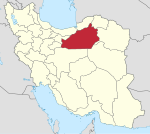| Sheikh Bastami Mosque | |
|---|---|
 | |
| Religion | |
| Affiliation | Islam |
| Province | Semnan Province |
| Location | |
| Location | Bastam, Iran |
| Architecture | |
| Architect(s) | Muhammad ibn al-Husayn al-Damghani [1] |
| Type | mosque, mausoleum, madrasah |
| Style | Seljuk, Ilkhanid |
| Completed | 14th century [2] |
| Specifications | |
| Dome(s) | 2 |
| Minaret(s) | 1 |
| Minaret height | 20 metres |
Sheikh Bastami Mosque is a 14th-century religious complex located in downtown Semnan Province, Bastam. It is named after Abu Yazid al-Bastami, better known as Bayazid Bastami, who is buried in that place alongside Muhammad ibn Ja'far al-Sadiq. The complex comprises a mosque, madrasah and the tombs of the aforementioned personalities. [3]
